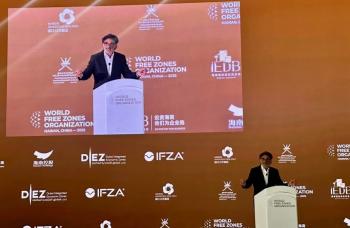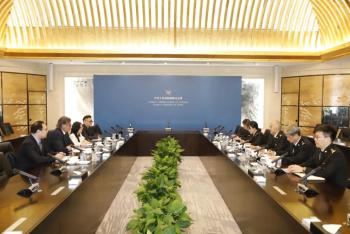IRU, the world road transport organisation, outlined three key measures to raise the efficiency, sustainability and safety of free zones at the World Free Zones Organization 2025 World Congress in China. In subsequent bilateral meetings with Chinese partners, IRU discussed the growing role of the TIR system in trade.
The World Free Zones Organization 2025 World Congress brought together more than 1,000 senior leaders – including CEOs, ministers, investors and multilateral institutions – in Hainan, China.
IRU Secretary General Umberto de Pretto, who delivered a keynote speech, said, “Road transport is the backbone of trade. It links ports to hinterlands, producers to consumers, and nations to global markets.”
“Trucks are also the 'glue' that connect air, sea and rail together, and, importantly, provide first and last mile connectivity. In this context, IRU’s work to advance safe, efficient and green logistics aligns perfectly with the ambitions of free zones," he added.

Faster, greener, safer
Firstly, integrating the global TIR transit system into free zone operations can make trade corridors faster and more predictable.
TIR supports the digitalisation of global trade. It offers an optimal balance between security and facilitation, a key enabler of safe trade for movements from, to and between free zones.
For example, TIR cuts transport times by up to 92% in the Gulf Cooperation Council region, with 80% of these movements emanating from free zones.
Secondly, IRU supports greener logistics with decarbonisation strategies for operators, shippers and public authorities.
IRU research has shown that a dual focus on rolling out alternative fuels pragmatically and implementing logistics efficiency gains is the best way to decarbonise road transport.
“About half of the reductions in CO2 emissions will come from efficiency gains and the other half from alternative fuels,” said Umberto de Pretto. “I call on free zones to work with IRU to drive greener logistics and trade.”
Thirdly, as free zones grow in complexity and scale, road safety becomes a critical dimension of their operational integrity.
High freight volumes, diverse vehicle types, and mixed-use infrastructure create unique safety challenges. By embedding IRU’s global safety standards into free zone operations, authorities can reduce accidents, improve efficiency, and build trust with investors and operators alike.
“The architecture of global trade is evolving rapidly, driven by geopolitical and technological change. I invite governments, free zones and the private sector to seize this moment and reimagine global trade,” concluded Umberto de Pretto.
High-level talks
In a subsequent bilateral meeting in Beijing with Vice Minister Wang Jun of the General Administration of Customs of the People's Republic of China (GACC), Umberto de Pretto recognised GACC’s role in expanding TIR in China.
TIR operations can now be initiated from over 50 Chinese borders and inland cities, connecting the country to more than 30 countries along the Belt and Road Initiative. From January to August 2025, TIR movements to/from China increased by nearly 200% compared to the same period in 2024.
The range of goods transported under TIR has expanded beyond industrial products and consumer goods. It now covers e-commerce, cold chain, dangerous goods, electronics, vehicles, and bulky goods.
Chinese customs is upgrading its system with new features, allowing all types of e-commerce and customs bonded cargo to be transported under TIR.

Wang Jun recognised the significant potential of TIR in China, stressing its crucial role in enhancing trade facilitation and advancing foreign trade.
"Chinese customs looks forward to deepening its cooperation with IRU to jointly expand usage scenarios and optimise the user experience of customs’ TIR system,” said Wang Jun. “We will actively participate in TIR-related events organised by IRU and the United Nations, ensuring our perspective is fully represented in the global dialogue on cross-border transport."
In a separate meeting with Ren Hongbin, the Chairman of the China Council for the Promotion of International Trade (CCPIT), Umberto de Pretto highlighted how the growing international road transport sector and expanding TIR routes offer Chinese traders diversified options to reach overseas markets, ensuring stronger supply chain security.
Ren Hongbin recognised the unique advantages of TIR in facilitating efficient trade. He stated that CCPIT will work closely with IRU to jointly promote TIR across its membership network and the broader Chinese trading community. This will help more businesses understand and benefit from its streamlined cross-border procedures.
IRU looks forward to continuing its work with GACC and CCPIT to further unleash the potential of TIR for Chinese foreign trade.
